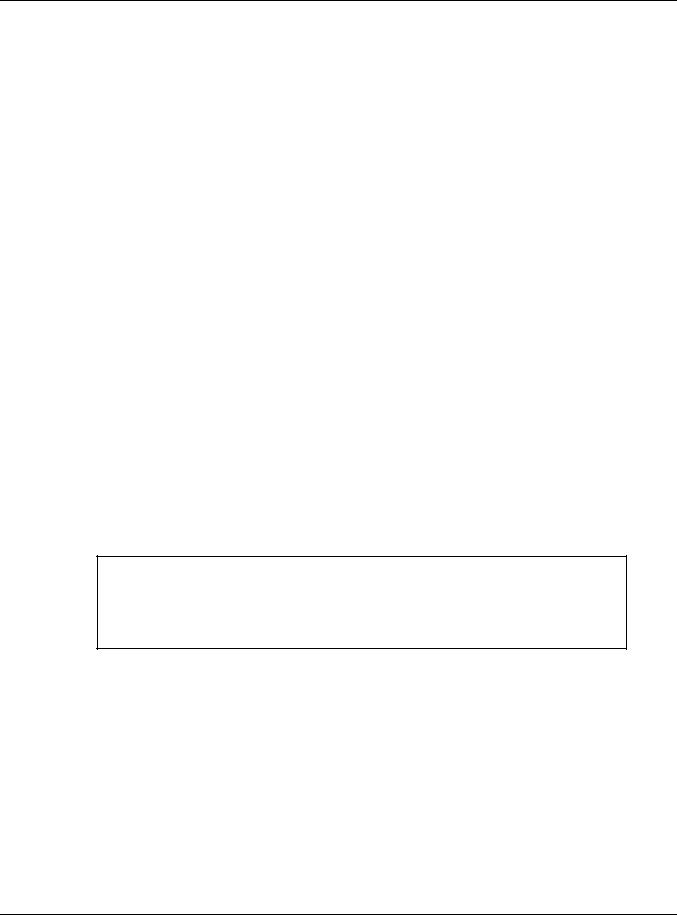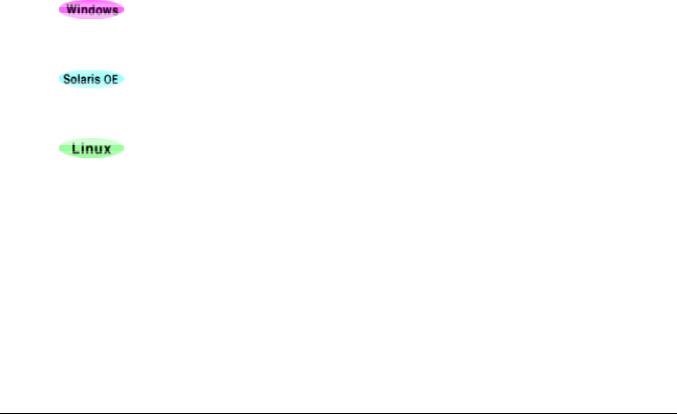Fujitsu Interstage Application Server User Manual

Interstage Application Server
V6.0
Product Notes

Product Notes
Trademarks
Trademarks of other companies are used in this user guide only to identify particular products or systems:
Product |
Trademark/Registered Trademark |
|
|
Microsoft, Visual Basic, Visual C++, |
Registered trademarks of Microsoft Corporation in |
Windows, Windows NT, Internet Information |
the U.S.A. and other countries |
Server, and Internet Explorer |
|
Sun, Solaris, Java, and other trademarks |
Trademarks of Sun Microsystems, Inc., in the |
containing Java |
U.S.A. and other countries |
UNIX |
Registered trademark in the U.S.A. and other |
|
countries, licensed exclusively through X/Open |
|
Company Ltd. |
Netscape, Netscape FastTrack Server, |
Registered trademarks of Netscape |
Netscape Enterprise Server, and Netscape |
Communications Corporation in the U.S.A. and |
Navigator |
other countries |
CORBA, Object Management Group, OMG, |
Trademarks or registered trademarks of Object |
OMG IDL, IIOP, Object Request Broker, and |
Management Group Inc. in the U.S.A. and other |
ORB |
countries |
Interstage and ObjectDirector |
Registered trademarks of Fujitsu Limited |
|
|
This document contains technology relating to strategic products controlled by export control laws of the producing and/ or exporting countries. This document or a portion thereof should not be exported (or re-exported) without authorization from the appropriate government authorities in accordance with such laws.
Fujitsu Limited
First Edition (November 2003)
The contents of this manual may be revised without prior notice.
All Rights Reserved, Copyright © FUJITSU LIMITED 2003
ii

Preface
Purpose of this Document
This manual provides additional information on the use of Interstage Application Server
Note
Throughout this manual Interstage Application Server is referred to as Interstage.
Who Should Read this Document?
This document is intended for users installing and operating Interstage Application Server. It is assumed that readers of this manual have a basic knowledge of:
•The Internet
•Apache
•Windows NT® ,Windows® 2000 and Windows 2003™ Server
•UNIX
•Linux
iii

Product Notes - Preface
Organization of this Document
This document is organized as follows:
•Chapter 1 - Supported Software
This chapter describes the supported software for application development and application execution. It also describes the client-side software products required to use client applications.
•Chapter 2 - Restrictions
This chapter describes the restrictions on some Interstage functions.
•Chapter 3 - Notes on Interstage Operation
This chapter provides notes about the operation of Interstage.
Functions that are not Supported by the Linux Version
The following functions are not supported by the Linux version. To use those functions, use the Windows version or Solaris™ Operating Environment version.
•Multi System (available only in the Solaris™ Operating Environment version)
•Cluster System
•Web Server (InfoProvider Pro)
•HTML Page Editing Service
•ebXML Message Service
•MessageQueueDirector
•MQ Communication Service
•InfoDirectory
•COBOL Web Subroutine
•COBOL/OOCOBOL development and execution environment (available on the Windows client)
•Firewall linkage function (proxy linkage and HTTP tunneling) and SSL linkage function of CORBA applications
•SMEE2 library (The SMEE3 library is available.)
•Online access management function
•Performance monitoring tool (real-time monitoring function of performance information)
•User authentication and access control of the Component Transaction Service
•AIM linkage function
iv

Table of Contents
Chapter 1 Supported Software |
|
Software Products Required for Application Development............................................................. |
1-2 |
J2EE (Exclude Security) ............................................................................................................ |
1-2 |
Security ...................................................................................................................................... |
1-3 |
Operation / Administration ......................................................................................................... |
1-4 |
Framework ................................................................................................................................. |
1-5 |
Other Functions ......................................................................................................................... |
1-5 |
Software Products Required for Application Execution .................................................................. |
1-7 |
J2EE (Exclude Security) ............................................................................................................ |
1-7 |
Security ...................................................................................................................................... |
1-8 |
Operation / Administration ......................................................................................................... |
1-8 |
Framework ............................................................................................................................... |
1-10 |
Portal Component.................................................................................................................... |
1-10 |
Other Functions ....................................................................................................................... |
1-11 |
Client-side Software Products Required to Use Client Applications............................................. |
1-12 |
J2EE (Exclude Security) .......................................................................................................... |
1-12 |
Security .................................................................................................................................... |
1-13 |
Framework ............................................................................................................................... |
1-13 |
Other Functions ....................................................................................................................... |
1-14 |
Chapter 2 Restrictions |
|
Restrictions on Interstage HTTP Server ......................................................................................... |
2-2 |
Restrictions on InfoProvider Pro ..................................................................................................... |
2-3 |
Restrictions on the J2EE Service ................................................................................................... |
2-4 |
Restrictions on the Servlet Service................................................................................................. |
2-5 |
Restrictions on the EJB Service ..................................................................................................... |
2-6 |
Restrictions on the SOAP Service ................................................................................................ |
2-11 |
Restrictions on the CORBA Service ............................................................................................. |
2-13 |
Restrictions on IDL Definitions................................................................................................. |
2-13 |
Restrictions on IDL Compilation .............................................................................................. |
2-17 |
Restrictions on C and C++ Programming................................................................................ |
2-17 |
v

Product Notes - Table of Contents
Restrictions on Java Programming.......................................................................................... |
2-18 |
Restrictions on the Naming Service......................................................................................... |
2-18 |
Restrictions on the CORBA Service ........................................................................................ |
2-19 |
Restrictions on the Event Service ................................................................................................. |
2-20 |
Restrictions on the Component Transaction Service.................................................................... |
2-21 |
Restrictions on the Database Linkage Service ............................................................................. |
2-22 |
Restrictions on the Locale of Languages ................................................................................ |
2-22 |
Restrictions on InfoDirectory......................................................................................................... |
2-23 |
Restrictions on the InfoDirectory Administration Tool .............................................................. |
2-23 |
Restrictions on the JNDI .......................................................................................................... |
2-23 |
Restrictions on JDK/JRE............................................................................................................... |
2-24 |
Restrictions on the Portal Component .......................................................................................... |
2-25 |
Restrictions on Scripts in Contents.......................................................................................... |
2-25 |
Restrictions on the Alternative Logon Function ....................................................................... |
2-26 |
Restrictions on the Load Distribution Environment.................................................................. |
2-27 |
Restrictions on Using Netscape 4.6/4.7................................................................................... |
2-27 |
Restrictions on Using Web USP (List of URLs to be Excluded With Form Authentication |
|
Inherited) .................................................................................................................................. |
2-28 |
Access from PC to Secure Site (HTTPS) ................................................................................ |
2-28 |
Restrictions on Using the Brick Automatic Update Function ................................................... |
2-28 |
Restrictions on Other Functions.................................................................................................... |
2-29 |
Chapter 3 Notes on Interstage Operation |
|
Common Notes for Interstage......................................................................................................... |
3-2 |
About Netscape 6 ...................................................................................................................... |
3-2 |
About the Cross-Site Scripting Problem .................................................................................... |
3-2 |
Using the JSSE Function........................................................................................................... |
3-3 |
Monitor Screen Colors ............................................................................................................... |
3-4 |
Setting Port Numbers Used for Individual Services................................................................... |
3-5 |
Notes on the Interstage Operation Tool .......................................................................................... |
3-9 |
Version Level of Each Service Performing the Operation ......................................................... |
3-9 |
Notes on the Interstage Integration Commands ........................................................................... |
3-10 |
Dealing with Abnormal Command Termination........................................................................ |
3-10 |
Starting and Stopping Services................................................................................................ |
3-10 |
Note on Stopping Interstage .................................................................................................... |
3-10 |
Notes on the InfoProvider Pro....................................................................................................... |
3-11 |
Notes on the Interstage HTTP Server........................................................................................... |
3-12 |
Authority to Use the Interstage HTTP Server .......................................................................... |
3-12 |
vi

Product Notes - Table of Contents |
|
|
Notes on Operating Interstage HTTP Server .......................................................................... |
3-12 |
|
Notes on J2EE .............................................................................................................................. |
3-13 |
|
Notes on the Servlet Service ........................................................................................................ |
3-15 |
|
Notes on Using the EJB Service................................................................................................... |
3-16 |
|
Version of Java Development Kit/Java Runtime Environment ................................................ |
3-16 |
|
Notes on the EJB Customize Tool ........................................................................................... |
3-16 |
|
When Operating with WorkUnits.............................................................................................. |
3-18 |
|
When Interstage JDBC Driver is Used .................................................................................... |
3-19 |
|
Note on Class Names.............................................................................................................. |
3-22 |
|
Starting EJB Applications......................................................................................................... |
3-22 |
|
About the EJB Application Process ......................................................................................... |
3-22 |
|
Notes on SOAP Service................................................................................................................ |
3-23 |
|
When Encryption Communication by SSL is Used.................................................................. |
3-23 |
|
When Session Recovery Function of Servlet Service is Used................................................ |
3-23 |
|
When J2EE Management Tool or J2EE Deployment Tool is Used ......................................... |
3-23 |
|
Notes on the CORBA Service....................................................................................................... |
3-24 |
|
Notes on Installation and Environment Settings...................................................................... |
3-24 |
|
Notes about Setting Applications............................................................................................. |
3-25 |
|
Notes on the IDL Compiler ...................................................................................................... |
3-26 |
|
Notes on the Java Environment............................................................................................... |
3-26 |
|
Notes on SSL communication ................................................................................................. |
3-26 |
|
Notes on the Event Service .......................................................................................................... |
3-27 |
|
Note on Reinitializing Interstage.............................................................................................. |
3-27 |
|
Notes on SSL Communication................................................................................................. |
3-27 |
|
Note on Unit Generation .......................................................................................................... |
3-27 |
|
Note on Persistent Channel Applications ................................................................................ |
3-28 |
|
Notes on Multi-IP Address Operation ...................................................................................... |
3-28 |
|
Notes on the Component Transaction Service ............................................................................. |
3-29 |
|
Note on Messages in Windows® 2000 ................................................................................... |
3-29 |
|
About CORBA Service Termination using the isstop Command ............................................. |
3-29 |
|
Monitoring during Interstage Operation ................................................................................... |
3-29 |
|
Notes on the Database Linkage Service ...................................................................................... |
3-30 |
|
Notes on OTS Command Execution ....................................................................................... |
3-30 |
|
Notes on the Use of Oracle ..................................................................................................... |
3-30 |
|
Notes on Development using Functions for the Java Language Provided by the Database |
|
|
Linkage Service of Interstage 1.1 or Earlier ............................................................................ |
3-31 |
|
Maximum Number of Resources for One Transaction ............................................................ |
3-31 |
|
Sample Provided with Database Linkage Service................................................................... |
3-31 |
|
CORBA Server Application is Operated using Multi Thread.................................................... |
3-31 |
|
vii

Product Notes - Table of Contents
Notes on InfoDirectory .................................................................................................................. |
3-32 |
Setup Item Related to the Maximum Simultaneous Number of Clients Connected................ |
3-32 |
Error Messages in the Event Log ............................................................................................ |
3-32 |
Notes on JDK/JRE ........................................................................................................................ |
3-33 |
Notes on Java VM.................................................................................................................... |
3-33 |
Notes on OutOfMemoryError Caused by a Permanent Area Shortage................................... |
3-33 |
Notes on java.lang.Object.wait().............................................................................................. |
3-33 |
Notes on the Return Value of java.beans.PropertyDescriptor.getWriteMethod() .................... |
3-34 |
Notes on Portal Component.......................................................................................................... |
3-35 |
Notes on Contents Use............................................................................................................ |
3-35 |
Notes at Logon......................................................................................................................... |
3-35 |
Notes on Portal Component Server Operating Mode.............................................................. |
3-35 |
Notes on USP Use................................................................................................................... |
3-37 |
Notes on Web USP Use ..................................................................................................... |
3-37 |
Notes on Web To Host USP(S2K USP) Use ...................................................................... |
3-37 |
Notes when Applying Portal Component Independent Authentication to Operation |
|
Management ............................................................................................................................ |
3-37 |
Notes on Using Operation Management Tool Commands ...................................................... |
3-38 |
Notes on Portal Component Repository Database Operation................................................. |
3-38 |
About the Specification of Keep-alive between WebUSP and Back Server............................ |
3-38 |
Notes when Using a Long Character String for Alias .............................................................. |
3-38 |
Notes on Using Administrative Console .................................................................................. |
3-39 |
Setting the Heap Size in the Java Execution Environment ..................................................... |
3-39 |
Notes on Framework..................................................................................................................... |
3-40 |
Security on the Internet............................................................................................................ |
3-40 |
Redistributable Files ................................................................................................................ |
3-40 |
Index
viii

Chapter 1
Supported Software
This chapter describes the supported software.
1-1

Chapter 1: Supported Software
Software Products Required for Application Development
This section describes software products required for application development.
J2EE (Exclude Security)
Table 1-1 lists the J2EE (exclude security) products required for application development.
Table 1-1 J2EE (Exclude Security) Products Required for Application Development
No. |
Function Name |
Product Name |
Version |
|
|
|
|
1 |
Development of J2EE |
Any of |
|
|
applications (*1) |
Interstage Apworks (*2) |
V5.0 or later |
|
|
Interstage Application Server Plus |
|
|
|
Developer |
V5.0.1 or later |
|
|
|
|
2 |
Development of EJB applications |
SymfoWARE® Server Enterprise |
V5.0 or later (*3) |
|
using databases. |
Edition for Windows |
|
|
|
Oracle8i Enterprise Edition |
R8.1.5 (*3) |
|
|
|
R8.1.6 (*3) |
|
|
|
R8.1.7 (*3) |
|
|
|
|
|
|
Oracle9i Database Enterprise |
Release1 (9.0.1) (*3) |
|
|
Edition |
|
|
|
SQL Server |
2000 (*3) |
|
|
|
|
*1) JDK1.1 and JDK1.2 are not applicable.
*2) If the JSP remote debug function is to be used, the version of the Servlet service must match the version of Apworks. For this reason, use V6.0.
*3) SymfoWARE Server Enterprise Edition or Oracle8i Enterprise Edition or Oracle9i Database Enterprise Edition is required.
Use the JDBC driver for JDK 1.2 when you use Symfoware Server Enterprise Edition and Symfoware Server. Moreover, the JDBC driver for JDK1.2 can use the version of JDK/JRE by 1.2 or later. Do not download it though it is described, “The JNDI class library (jndi package) and JDBC2.0 Optional Package (javax.sql package) can be downloaded from the homepage of Javasoft of SUN Microsystems” in JDBC driver online manual of Symfoware when the JDBC driver for JDK1.2 is used.
1-2

Software Products Required for Application Development
Use the product since V4.0L10 when you use either Symfoware Server Enterprise Edition or Symfoware Server when you use the Symfoware with RDB2_TCP.
When the decentralized transaction function by JTS and JTA is used, Oracle8i Enterprise Edition R8.1.7 or Oracle 9i Database Enterprise Edition is required.
Use the Interstage JDBC Driver included while packaging the EJB Service when you use SQL Server. Refer to the associated software manual when using it. The software manual is in the following place.
Interstage installation folder\EJB\jdbc\fjisjdbc.txt Interstage JDBC Driver can be used only with JDK/JRE1.3.
Install the SQL Server client tool in the execution environment of Interstage JDBC Driver when the installation environment of the execution environment of Interstage JDBC Driver and SQL Server is different.
Security
Table 1-2 lists the security products required for application development.
Table 1-2 Security Products Required for Application Development
No. |
Function Name |
Product Name |
Version |
|
|
|
|
1 |
SSL communication function of |
Systemwalker PkiMGR (*1) |
V1.0 |
|
CORBA Service |
|
|
|
|
|
|
*1) It is required on the server issuing certification. It is not required when you acquire certification from Certificate issue organization.
At the time of UTF-8 certificate creation, Systemwalker PkiMGR is required.
1-3

Chapter 1: Supported Software
Operation / Administration
Table 1-3 lists the operation/administration products required for application development.
Table 1-3 Operation/Administration Products Required for Application Development
No. |
Function Name |
Product Name |
Version |
|
|
|
|
1 |
Real-time monitoring by |
Systemwalker CentricMGR |
V5.0L20 or V5.0L30 or |
|
performance monitoring tool and |
|
later |
|
operation management linked to |
|
(*1) |
|
Systemwalker |
|
|
2 |
Automatic operation linked to |
Systemwalker OperationMGR |
V5.0L20 or V5.0L30 or |
|
Systemwalker |
|
later |
|
|
|
(*2) |
|
|
|
|
3 |
Interstage Operation Tool |
Microsoft® Internet Explorer |
5.01, 5.5, or 6.0 |
|
|
or |
6 Series or 7 Series |
|
|
Netscape® Communicator |
|
|
|
|
|
|
|
|
|
4 |
Real-time monitoring function of |
SNMP service |
Windows NT® 4.0 |
|
performance information by the |
|
Windows® 2000 |
|
Network Manager |
|
|
|
|
(*3) |
|
|
|
|
|
|
|
|
|
*1) If the version level of Systemwalker CentricMGR to be linked is V5.0L20, the following functions cannot be used:
−Operation status monitoring of the EJB WorkUnit (for old version compatible environment)
−Displaying information on the multi object-resident objects
−Real-time monitoring of the application processing status
If the version level of Systemwalker CentricMGR is V10L10 or earlier, the following functions cannot be used:
−Monitoring of the CORBA WorkUnit operating status
−Monitoring of the Servlet container unit operating status (old version Servlet service)
−Real-time monitoring of the application processing status for the Implementation Repository of the CORBA WorkUnit
−Real-time monitoring of the EJB application processing status of the EJB WorkUnit (for old version compatible environment)
−Information display of EJB applications on the Light EJB container (for old version compatible environment)
−Operating status monitoring of the Light EJB container (for old version compatible environment)
1-4

Software Products Required for Application Development
*2) If the version level of Systemwalker OperationMGR to be linked is V5.0L20, the EJB WorkUnit (for old version compatible environment) cannot be operated automatically.
The following functions also cannot be used if the version level of Systemwalker OperationMGR is V10.0L10 or earlier.
−Automatic operation of the CORBA WorkUnit
−Automatic operation of the Light EJB container WorkUnit (for old version compatible environment)
*3) The SNMP Service is a function provided by the operating system.
Framework
Table 1-4 lists the framework products required for application development.
Table 1-4 Framework Products Required for Application Development
No. |
Function Name |
Product Name |
Version |
|
|
|
|
1 |
Using database linkage |
Oracle Database Enterprise |
Release1(9.0.1) or |
|
components of the Framework |
Edition / Standard Edition |
Release2(9.2.0) |
|
function |
|
|
|
Symfoware Server Enterprise |
V5.0 |
|
|
|
||
|
|
Edition |
|
|
|
|
|
2 |
Using XML linkage function of the |
Fujitsu XML Processor |
V5.1.1 |
|
Framework function |
- Fujitsu XML Library for Java |
|
|
|
- Fujitsu XSLT Library for Java |
|
|
|
|
|
3 |
Using Struts linkage function of |
Struts |
1.1 |
|
the Framework function |
|
|
Other Functions
Table 1-5 lists the products required for application development (other functions).
Table 1-5 Products Required for Application Development (Other Functions)
No. |
Function Name |
Product Name |
Version |
|
|
|
|
1 |
Development of applications of |
Interstage Apworks or |
V6.0 |
|
the SOAP Service |
Interstage Application Server Plus |
|
|
|
Developer (*1) |
|
|
|
|
|
2 |
Development of applications |
Interstage Apworks or |
V6.0 |
|
using UDDI client |
Interstage Application Server Plus |
|
|
|
Developer (*1) |
|
|
|
|
|
1-5

Chapter 1: Supported Software
No. |
Function Name |
Product Name |
Version |
|
|
|
|
3 |
Use of databases |
Symfoware® Server Enterprise |
V2.0L10 or later |
|
|
Edition for Windows |
edition |
|
|
|
|
|
|
Oracle7 |
R7.3.4 (*2) |
|
|
|
|
|
|
Oracle8 Enterprise Edition |
R8.0.5 (*2) |
|
|
|
|
|
|
Oracle8i Enterprise Edition |
R8.1.5 or R8.1.6 (*2) |
|
|
|
R8.1.7 |
|
|
|
|
|
|
Oracle9i Database Enterprise |
Release1 (9.0.1) |
|
|
Edition |
|
|
|
|
|
|
|
SQL Server |
6.5 or 7.0 |
|
|
|
|
4 |
Development of applications |
Microsoft® Visual C++ |
5.0, 6.0, .NET |
|
using LDAP SDK |
|
|
|
|
|
|
5 |
Directory service (Only when you |
Netscape Enterprise Server |
3.5 |
|
use Netscape Enterprise Server |
|
|
|
as WWW server) |
|
|
|
|
|
|
*1) JDK1.1 and JDK1.2 are not supported.
*2) At the time of using SynfinityCLUSTER, it is required Symfoware Server Enterprise Edition V2.0L10 or later.
At the time of using JTS or JTA, Oracle Database Enterprise Edition R8.1.7, R9.0.1 or R9.2.0 is required.
1-6

Software Products Required for Application Execution
Software Products Required for Application Execution
This section describes software products required for application execution.
J2EE (Exclude Security)
Table 1-6 lists the J2EE (exclude security) products required for application execution.
Table 1-6 J2EE (Exclude Security) Products Required for Application Execution
No. |
Function Name |
Product Name |
Version |
|
|
|
|
1 |
Employment of the application which |
Oracle8i Enterprise Edition |
R8.1.5 (*1) (*2) |
|
uses a database |
|
|
|
Oracle8i Enterprise Edition |
R8.1.6 (*1) (*2) |
|
|
|
||
|
|
|
R8.1.7 (*1) (*2) |
|
|
|
|
|
|
Oracle 9i Database Enterprise |
Release1 (9.0.1) |
|
|
Edition |
(*1) (*2) |
|
|
SQL Server |
6.5 or 7.0 (*1) |
|
|
|
|
2 |
J2EE Management Tool |
Microsoft Internet Explorer® |
5.01, 5.5, 6.0 |
|
|
Netscape® Communicator |
4.7 type (*3) |
|
|
|
|
3 |
Old version Servlet Service (Only |
Microsoft Internet Information |
4.0 |
|
when Microsoft Internet Information |
Server |
5.0 (*4) |
|
Server or Microsoft Internet |
Microsoft Internet Information |
|
|
Information Services is used as the |
Services |
|
|
Web server) |
|
|
|
|
|
|
*1) Oracle8i Enterprise Edition or Oracle9i Database Enterprise Edition or SQL Server is required.
When the decentralized transaction function by JTS and JTA is used, Oracle8i Enterprise Edition R8.1.7 or Oracle9i Database Enterprise Edition is essential.
Use Interstage JDBC Driver included while packaging the EJB Service when you use SQL Server. Refer to the associated software manual when using it. The software manual is in the following place.
Interstage installation folder\EJB\jdbc\fjisjdbc.txt Interstage JDBC Driver can be used only with JDK/JRE1.3.
Install the SQL Server client tool in the execution environment of Interstage JDBC Driver when the installation environment of the execution environment of Interstage JDBC Driver and SQL Server is different.
*2) When JDBC2.X of Oracle8i Enterprise Edition R8.1.6 or R8.17 or Oracle9i Database Enterprise Edition is used, download File System Service Provider 1.2 from the JavaSoft site(http://www.javasoft.com/). The file name as of June 8, 2001 is fscontext1_2beta3.zip, however note that this may be changed without notice. When the downloaded files are decompressed, the following files are restored:
1-7

Chapter 1: Supported Software
−providerutil.jar
−fscontext.jar
*3) If Netscape 4.7 type is used, a screen display error may occur.
*4) Microsoft Internet Information Services 6.0 or later cannot be used.
Security
Table 1-7 lists the security products required for application execution.
Table 1-7 Security Products Required for Application Execution
No. |
Function Name |
Product Name |
Version |
|
|
|
|
1 |
SSL communication function of |
Systemwalker PkiMGR (*1) |
V1.0 |
|
Web Server, CORBA Service, |
|
|
|
Portable-ORB and J2EE. |
|
|
|
|
|
|
*1) It is required on the server issuing certification. It is not required when you acquire certification from Certificate issue organization.
At the time of UTF-8 certificate creation, Systemwalker PkiMGR is required.
Operation / Administration
Table 1-8 lists the operation/administration products required for application execution.
Table 1-8 Operation/Administration Products Required for Application Execution
No. |
Function Name |
Product Name |
Version |
|
|
|
|
1 |
Real-time monitoring by |
Systemwalker CentricMGR |
V5.0L20 or V5.0L30 or |
|
performance monitoring tool and |
|
later |
|
operation management linked to |
|
(*1) |
|
Systemwalker |
|
|
|
|
|
|
2 |
Automatic operation linked to |
Systemwalker OperationMGR |
V5.0L20 or V5.0L30 or |
|
Systemwalker |
|
later |
|
|
|
(*2) |
3 |
Interstage Operation Tool |
Microsoft® Internet Explorer |
5.01, 5.5, or 6.0 |
|
|
or |
6 Series or 7 Series |
|
|
Netscape® Communicator |
|
|
|
|
|
|
|
|
|
4 |
Real-time monitoring function of |
SNMP service |
Windows NT® 4.0 |
|
performance information by the |
|
Windows® 2000 |
|
Network Manager |
|
|
|
|
(*3) |
|
|
|
|
|
|
|
|
|
1-8

Software Products Required for Application Execution
*1) If the version level of Systemwalker CentricMGR to be linked is V5.0L20, the following functions cannot be used:
−Operation status monitoring of the EJB WorkUnit (for old version compatible environment)
−Displaying information on the multi object-resident objects
−Real-time monitoring of the application processing status
If the version level of Systemwalker CentricMGR is V10L10 or earlier, the following functions cannot be used:
−Monitoring of the CORBA WorkUnit operating status
−Monitoring of the Servlet container unit operating status (old version Servlet service)
−Real-time monitoring of the application processing status for the Implementation Repository of the CORBA WorkUnit
−Real-time monitoring of the EJB application processing status of the EJB WorkUnit (for old version compatible environment)
−Information display of EJB applications on the Light EJB container (for old version compatible environment)
−Operating status monitoring of the Light EJB container (for old version compatible environment)
*2) If the version level of Systemwalker OperationMGR to be linked is V5.0L20, the EJB WorkUnit (for old version compatible environment) cannot be operated automatically.
The following functions also cannot be used if the version level of Systemwalker OperationMGR is V10.0L10 or earlier.
−Automatic operation of the CORBA WorkUnit
−Automatic operation of the Light EJB container WorkUnit (for old version compatible environment)
*3) The SNMP Service is a function provided by the operating system.
1-9

Chapter 1: Supported Software
Framework
Table 1-9 lists the framework products required for application execution.
Table 1-9 Framework Products Required for Application Execution
No. |
Function Name |
Product Name |
Version |
|
|
|
|
1 |
Using database linkage |
Oracle Database Enterprise |
Release1(9.0.1), or |
|
components of the framework |
Edition / Standard Edition |
Release2(9.2.0) |
|
function |
|
|
|
Symfoware Server Enterprise |
V5.0 |
|
|
|
||
|
|
Edition |
|
|
|
|
|
2 |
Using XML linkage function of the |
Fujitsu XML Processor |
V5.1.1 |
|
framework function |
- Fujitsu XML Library for Java |
|
|
|
- Fujitsu XSLT Library for Java |
|
|
|
|
|
3 |
Using Struts linkage function of |
Struts |
1.1 |
|
the framework function |
|
|
Portal Component
Table 1-10 lists the Portal component products required for application execution.
Table 1-10 Portal Component Products Required for Application Execution
No |
Function Name |
Product Name |
Version |
|
|
|
|
1 |
Directory server (*1) |
InfoDirectory |
The LDAP system |
|
|
|
enclosed by Interstage |
|
|
|
Application Server V6.0 |
|
|
|
or V1.2L10 |
|
|
Netscape Directory Server |
Ver.3.11 (supported only |
|
|
|
by Windows NT®) |
2 |
Web Server |
Interstage HTTP Server |
V6.0 |
|
|
|
|
|
|
Microsoft Internet Information Server |
4.0/5.0 |
|
|
|
|
3 |
RDBMS for repository (*2) |
Oracle8i Enterprise Edition |
R8.1.6/R8.1.7 |
|
|
|
|
|
|
Oracle9i database enterprise edition |
Release1(9.0.1) |
|
|
|
Release2(9.0.2) |
4 |
Web browser(Administrative |
Microsoft Internet Explorer |
5.5/6.0 |
|
Console) |
|
|
5 |
Web browser(User Page) |
Microsoft Internet Explorer |
5.0/5.01/5.5/6.0 |
|
|
|
|
|
|
Netscape Navigator |
4.6/4.7 |
|
|
|
|
*1) To use LDAP as an authentication system, it is necessary to install an LDAP system and to register its users. For more details, refer to the manual for your LDAP product.
1-10

Software Products Required for Application Execution
*2) It is possible to change the repository (Fujitsu Enabler) of the Portal component installed by default to RDB by using the repository change command immediately after installation. For more details, refer to the Portalworks Administration Guide.
Other Functions
Table 1-11 lists the products required for application execution (other functions).
Table 1-11 Products Required for Application Execution (Other Functions)
No. |
Function Name |
Product Name |
Version |
|
|
|
|
1 |
Directory Service (Only when |
Netscape Enterprise Server |
3.5 |
|
Netscape Enterprise Server is the |
|
|
|
WWW server) |
|
|
2 |
Use of Databases |
Symfoware Server Enterprise |
V1.2L11 or later |
|
(Excluding EJB application) |
Edition |
|
|
|
|
|
|
|
Oracle7 |
R7.3.4 |
|
|
|
|
|
|
Oracle8 Enterprise Edition |
R8.0.5 |
|
|
|
|
|
|
Oracle8i Enterprise Edition |
R8.1.5 |
|
|
|
|
|
|
Oracle8i Enterprise Edition |
R8.1.6 |
|
|
|
R8.1.7 |
|
|
|
|
|
|
Oracle 9i Database Enterprise |
Release1 (9.0.1) |
|
|
Edition |
|
|
|
SQL Server |
6.5 or 7.0 |
|
|
|
|
1-11

Chapter 1: Supported Software
Client-side Software Products Required to Use Client Applications
This section describes the client-side software products required to use client applications.
J2EE (Exclude Security)
Table 1-12 lists the J2EE (Exclude Security) client-side software products required to use client applications.
Table 1-12 J2EE (Exclude Security) Client-side Software Required to Use Client Applications
No |
Function Name |
Product Name |
Version |
|
|
|
|
1 |
Java application of EJB Service |
Interstage Apworks Server |
V5.0 or later |
|
(including Java applet) |
Runtime Package (*1) |
|
|
|
|
|
2 |
Java applet of EJB Service (*2) (*3) |
Netscape Communicator |
4.06, 4.07, 4.08, 4.5, |
|
|
|
4.51, 4.6, 4.7, 4.72, |
|
|
|
4.73 or 4.75 |
|
|
|
|
|
|
Microsoft Internet Explorer |
4.01, 5.0, 5.01 or 5.5 |
|
|
|
(*4) |
|
|
|
|
3 |
Operation of J2EE application clients |
Interstage Apworks Server |
V5.0 or later |
|
using JNDI, JMS, JavaMail. |
Runtime Package (*5) |
|
|
|
|
|
*1) This product is required when a Java application (including a Java applet) of the EJB service is created.
*2) To operate Java applets, the following formats are available:
−Format to download the Portable-ORB and EJB Service client from the WWW server:
The jar file (fjcontainer32_plugin.jar) for the Portable-ORB and the client of the EJB Service must first be installed (resource must be stored) in the WWW server.
The JBK plugin provided by "J Business Kit," a component of Apworks V6.0L10, is required. The Apworks download installer must be installed in advance.
−Format to install the CORBA Service client and EJB Service client:
The CORBA Service client and EJB Service client must first be installed in the client.
If installation is performed without selecting JBK in custom installation mode, the JBK plugin must be installed in advance.
*3) As the Web browser, either Netscape Communicator or Microsoft Internet Explorer is required.
1-12

Client-side Software Products Required to Use Client Applications
*4) Service Pack 1 or Service Pack 2 is necessary for Microsoft Internet Explorer 4.01. Also, Software Development Kit for Java V4.0 is necessary for creating cab files used in Microsoft Internet Explorer.
*5) JDK1.1 and JDK1.2 are not supported.
Security
Table 1-13 lists the security client-side software products required to use client applications.
Table 1-13 Security Client-side Software Required to Use Client Applications
No |
Function Name |
Product Name |
Version |
|
|
|
|
1 |
Encrypted communication with 128bit |
Netscape Communicator |
4.7 |
|
|
|
|
|
|
Microsoft Internet Explorer |
5.01 |
|
|
and high reliability pack |
|
|
|
(128bit) |
|
|
|
|
|
Framework
Table 1-14 lists the framework client-side software products required to use client applications.
Table 1-14 Framework Client-side Software Required to Use Client Applications
|
No |
Function Name |
Product Name |
Version |
|
|
|
|
|
|
|
|
1 |
Client (Windows®) for the web |
Microsoft Internet Explorer |
5.x or 6.0 |
|
|
|
application using Framework |
|
|
|
|
|
Netscape Communicator |
4.7x |
||
|
|
|
|||
|
|
|
|
|
|
|
2 |
Client (Macintosh®) for the web |
Microsoft Internet Explorer |
5.1 for Mac (OS8.1 |
|
|
|
application using Framework |
|
9.x) or |
|
|
|
|
|
5.2 for Mac (OS X) |
|
|
|
|
|
|
|
|
|
|
Netscape |
7.1 (Mac OS X) |
|
|
|
|
|
|
|
|
|
|
Safari |
1.0 |
|
|
|
|
|
|
|
|
3 |
Using Applet linkage function of the |
Interstage Application Server |
- |
|
|
|
Framework function |
Plus V6.0 |
|
|
|
|
|
Interstage Application Server |
|
|
|
|
|
Plus Developer V6.0 |
|
|
|
|
|
|
|
|
|
|
|
Java Plug-in |
1.3.1, 1.4.1, 1.4.2 |
|
|
|
|
|
|
|
|
|
|
|
|
|
1-13

Chapter 1: Supported Software
Other Functions
Table 1-15 lists the client-side software products required to use client applications (other functions).
Table 1-15 Client-side Software Required to Use Client Applications (Other Functions)
No |
Function Name |
Product Name |
Version |
|
|
|
|
1 |
WWW Server Linkage |
Netscape Communicator |
4.0, 4.01, 4.02, 4.03, |
|
|
|
4.04, 4.05, 4.06, 4.07, |
|
|
|
4.08, 4.5, 4.51, 4.6 or |
|
|
|
4.7 |
|
|
|
|
|
|
Microsoft Internet Explorer |
4.0, 5.0, 5.01 or 5.5 |
|
|
|
(*1) |
|
|
|
|
2 |
SOAP Service client |
INTERSTAGE APWORKS |
V4.1 or later |
|
|
Client Runtime package |
|
|
|
|
|
|
|
Interstage Apworks Client |
V5.0 |
|
|
Runtime Package |
|
|
|
|
|
|
|
INTERSTAGE Java Server |
V4.1 or later |
|
|
package (*2) |
|
|
|
|
|
|
|
Interstage Java Server |
V5.0 or later |
|
|
package (*3) |
|
|
|
|
|
|
|
JCE (Java Cryptography |
1.2.2 |
|
|
Extension) (*4) |
|
3 |
Using the UDDI client |
INTERSTAGE APWORKS |
V5.0 |
|
|
Client Runtime package (*5) |
|
4 |
Using the InfoDirectory web connector |
Netscape Navigator |
4.7, 4.73, 4.75 |
|
|
|
|
|
|
Netscape Communicator |
4.7, 4.72, 4.73, 4.75, |
|
|
|
4.76, 4.78 |
|
|
|
|
|
|
Netscape |
6.0, 6.1, 6.2 |
|
|
|
|
|
|
Microsoft Internet Explorer |
5.01, 5.5, 6.0 |
|
|
|
|
*1) Service Pack 1 or Service Pack 2 is necessary for Microsoft Internet Explorer 4.01. Also, Software Development Kit for Java V4.0 is necessary for creating cab files used in Microsoft Internet Explorer.
*2) Use the functions corresponding to the APWORKS Client Runtime Package in the Interstage Java Server Package. For details of the functions corresponding to the APWORKS Client Runtime Package in the Interstage Java Server Package, refer to Section 4.6 Download Installer in \DATA4\READMEAP.TXT on the Interstage Java Server Package CD-ROM.
*3) When using the remote installation function of the EJB Deployment tool, the Interstage Operation Tool needs to be installed on the server for installation.
*4) Required when password management function for client authentication of SSL communication of SOAP Service client side is used.
*5) JDK1.1 and JDK1.2 are not supported.
1-14

Chapter 2
Restrictions
Some functions described in this manual have restrictions. The following tables detail these restrictions.
2-1

Chapter 2: Restrictions
Restrictions on Interstage HTTP Server
Table 2-1 Restrictions on Interstage HTTP Server
No. |
Restriction |
Remarks |
Date of |
|
|
|
Removal |
|
|
|
|
1 |
When a certificate in UTF-8 format, |
None |
Not |
|
(such as a CA certificate, site certificate, |
|
determined |
|
or client certificate) is used for SSL |
|
|
|
communication, the following restrictions |
|
|
|
apply: |
|
|
|
- When SSL protocol Version 3 (client |
|
|
|
certificate) is used, the CA certificate |
|
|
|
and the client certificate in UTF-8 must |
|
|
|
be registered on both the Interstage |
|
|
|
HTTP Server and the web browser. |
|
|
|
- When SSL protocol Version 2 (server |
|
|
|
authentication) is used, the CA |
|
|
|
certificate and the client certificate in |
|
|
|
UTF-8 must be registered on both the |
|
|
|
Interstage HTTP Server and the web |
|
|
|
browser. |
|
|
|
- If Interstage HTTP Server is started in |
|
|
|
either of the above SSL versions, normal |
|
|
|
access is available only via Internet |
|
|
|
Explorer 5.5 or 6.0 on Windows® 2000. |
|
|
|
|
|
|
2-2

Restrictions on InfoProvider Pro
Restrictions on InfoProvider Pro
Table 2-2 Restrictions on InfoProvider Pro
No. |
Restriction |
Remarks |
Date of |
|
|
|
Removal |
|
|
|
|
1 |
When a certificate in UTF-8 format, |
None |
Not |
|
(such as a CA certificate, site certificate |
|
determined |
|
or client certificate) is used for SSL |
|
|
|
communication, the following restrictions |
|
|
|
apply: |
|
|
|
- When SSL protocol Version 3 (client |
|
|
|
certificate) is used, the CA certificate |
|
|
|
and the client certificate in UTF-8 must |
|
|
|
be registered on both InfoProvider Pro |
|
|
|
and the web browser. |
|
|
|
- When SSL protocol Version 2 (server |
|
|
|
authentication) is used, the CA |
|
|
|
certificate and the client certificate in |
|
|
|
UTF-8 must be registered on both |
|
|
|
InfoProvider Pro and the web browser. |
|
|
|
- If InfoProvider Pro is started in either |
|
|
|
of the above SSL versions, normal |
|
|
|
access is available only via Internet |
|
|
|
Explorer 5.5 or 6.0 on Windows® 2000. |
|
|
2-3

Chapter 2: Restrictions
Restrictions on the J2EE Service
Table 2-3 Restrictions on the J2EE Service
No. |
Restriction |
Remarks |
Date of |
|
|
|
Removal |
|
|
|
|
1 |
If the EAR file is opened using the J2EE |
None. |
Not |
|
Deployment tool and the Application |
The files can be saved or |
determined |
|
Display Name of the application is |
|
|
|
deployed even if they are not |
|
|
|
changed, some contents such as class |
|
|
|
displayed. |
|
|
|
files may not be displayed in the |
|
|
|
|
|
|
|
General contents of the Web |
|
|
|
application. |
|
|
2 |
When the J2EE Deployment tool is |
Select the Cancel button. |
Not |
|
used, a save confirmation dialog box |
|
determined |
|
appears before closing a file. If the |
|
|
|
Close button on the title bar of the |
|
|
|
window is used, or if Close is selected |
|
|
|
from the window menu, the operation is |
|
|
|
the same as if No was selected. (Note |
|
|
|
that the operation in this case is not the |
|
|
|
same as if Cancel was selected!) |
|
|
|
|
|
|
3 |
When the J2EE Deployment tool is used |
None. |
Not |
|
with JDK/JRE1.3, the details of the file |
|
determined |
|
cannot be displayed on the File |
|
|
|
selection or Directory selection screen. |
|
|
|
|
|
|
4 |
The remote installation function of the |
Transfer the server distribution |
Not |
|
EJB Deployment tool cannot be used if |
generated with the EJB |
determined |
|
the installation destination machine is a |
Deployment tool to the operation |
|
|
cluster system. |
destination machine and install it |
|
|
|
with the ejbinstalleb command. |
|
|
|
For details on the ejbinstalleb |
|
|
|
command, see Chapter 5 |
|
|
|
ejbinstalleb in the Reference |
|
|
|
Manual (Command Edition). |
|
5 |
It is not possible to access the database |
When the global transaction is |
Not |
|
directly from a J2EE application client |
used with the JTA interface, be |
determined |
|
and a Web application while using the |
sure to access the database from |
|
|
global transaction with the JTA interface. |
an EJB application. |
|
|
|
|
|
6 |
Interstage cannot be stopped forcibly |
Stop the J2EE Deployment tool |
Not |
|
(the isstop command cannot be |
and then forcibly stop Interstage |
determined |
|
executed by specifying option -f) with |
(execute the isstop command by |
|
|
the J2EE Deployment tool activated. |
specifying option -f). |
|
|
|
|
|
2-4

Restrictions on the Servlet Service
Restrictions on the Servlet Service
Table 2-4 Restrictions on the Servlet Service
No. |
Restriction |
Remarks |
Date of |
|
|
|
Removal |
|
|
|
|
1 |
When Apworks is used for remote debugging, the |
Ignore this message. |
Not |
|
following may occur: |
|
determined |
|
When a Servlet service or servlet container is |
|
|
|
stopped, the following message is output to standard |
|
|
|
output or the standard input-output log file of the |
|
|
|
servlet container: |
|
|
|
"Internal debug-agent exception" |
|
|
|
|
|
|
2 |
The following phenomenon may occur when |
Start the debug of |
Not |
|
performing a remote debug using Apworks: |
Apworks after |
determined |
|
- The Servlet service may end abnormally if |
starting the Servlet |
|
|
service. |
|
|
|
JDK1.3(Java 2 Classic VM, JPDA) is used and the |
|
|
|
|
|
|
|
debug of Apworks is started before the Servlet |
|
|
|
service is started. |
|
|
2-5

Chapter 2: Restrictions
Restrictions on the EJB Service
Table 2-5 Restrictions on the EJB Service
No. |
Restriction |
Remarks |
Date of |
|
|
|
Removal |
|
|
|
|
1 |
The long type data type cannot be used as an argument |
None |
Not |
|
or return value for the client/server communication. |
|
determined |
2 |
In JDK/JRE 1.2.2, any class in which String data of 64 |
None |
Not |
|
KB or more is set to one variable in the class cannot be |
|
determined |
|
used as an argument or return value for EJB |
|
|
|
applications. |
|
|
|
|
|
|
3 |
In the client/server communication in JDK/JRE1.2.2, |
None |
Not |
|
when the interface shown below is used in business |
|
determined |
|
method parameters and return value, the method for the |
|
|
|
stored interface type cannot be issued. This is the case, |
|
|
|
even if the interface type that can be communicated in |
|
|
|
the application execution by the RMI over IIOP was |
|
|
|
stored in that interface. |
|
|
|
- java.util.Collection |
|
|
|
- java.util.Enumeration |
|
|
4 |
When defining a Bean in the Rapid invoking Bean, if it |
None |
Not |
|
uses JDK/JRE1.2.2, the return value cannot use the |
|
determined |
|
finder method of java.util.Enumeration or |
|
|
|
java.util.Collection. |
|
|
|
|
|
|
5 |
Using "remove" as a business method name may lead |
None |
Not |
|
to unexpected results. |
|
determined |
|
|
|
|
6 |
When distributed transactions are used, if any of the |
None |
Not |
|
following methods from the javax.ejb.EJBContext API |
|
determined |
|
are called from some particular methods, an |
|
|
|
IllegalStateException will be thrown. |
|
|
|
- getCallerIdentity() |
|
|
|
- getCallerPrincipal() |
|
|
|
- isCallerInRole(Identity role) |
|
|
|
- isCallerInRole(String roleName) |
|
|
|
If any of the above methods are called from one of the |
|
|
|
following methods, an exception will be thrown. |
|
|
|
- For STATEFUL Session Bean |
|
|
|
beforeCompletion |
|
|
|
afterCompletion |
|
|
|
- For Entity Bean |
|
|
|
ejbStore |
|
|
2-6

Restrictions on the EJB Service
No. |
Restriction |
Remarks |
Date of |
|
|
|
|
|
Removal |
|
|
|
|
|
7 |
If any of the above methods are called from one of the |
None |
Not |
|
|
following methods, an exception will be thrown. |
|
determined |
|
|
- getCallerIdentity() |
|
|
|
|
- getCallerPrincipal() |
|
|
|
|
- isCallerInRole(Identity role) |
|
|
|
|
- isCallerInRole(String roleName) |
|
|
|
|
If any of the above methods are called from one of the |
|
|
|
|
following methods, an exception will be thrown. |
|
|
|
|
- For STATEFUL Session Bean |
|
|
|
|
|
ejbRemove |
|
|
8 |
In the following cases, invoking a method that has |
None |
Not |
|
|
method permission setting from an EJB application |
|
determined |
|
|
method, a RemoteException is thrown. |
|
|
|
|
- When the distributed transaction function is used |
|
|
|
|
|
[STATEFUL Session Bean] |
|
|
|
|
beforeCompletion |
|
|
|
|
[Entity Bean] |
|
|
|
|
ejbStore |
|
|
|
- |
When the Session Timeout function is used |
|
|
|
|
[STATEFUL Session Bean] |
|
|
|
|
ejbRemove |
|
|
9 |
If |
"Application" is specified in the resource connector of |
None |
Not |
|
the deployment descriptor file, and a JDBC resource is |
|
determined |
|
|
being accessed from an EJB application method, an |
|
|
|
|
SQLException is thrown in the following cases. |
|
|
|
|
- |
When the distributed transaction function is used |
|
|
|
|
[STATEFUL Session Bean] |
|
|
|
|
beforeCompletion |
|
|
|
|
[Entity Bean] |
|
|
|
|
ejbStore |
|
|
|
- |
When the Session Timeout function is used |
|
|
|
|
[STATEFUL Session Bean] |
|
|
|
|
ejbRemove |
|
|
|
|
|
|
|
10 |
If |
"Application" is specified in the resource connector of |
None |
Not |
|
the deployment descriptor file, and a JDBC resource is |
|
determined |
|
|
being accessed from an EJB application method, an |
|
|
|
|
SQLException is thrown in some cases. |
|
|
|
11 |
If distributed transactions are used and the Snap output |
None |
Not |
|
|
level is set to "2", an ORA-01002 error in Oracle may be |
|
determined |
|
|
thrown. |
|
|
|
|
|
|
|
|
2-7
